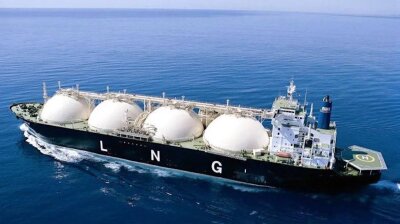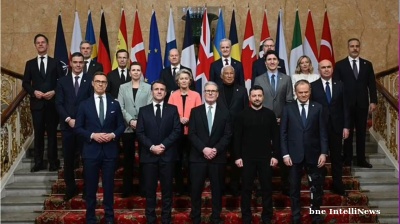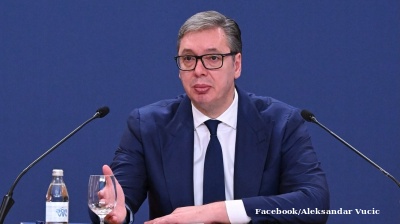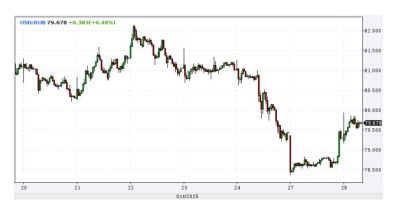COMMENT: EU's LNG import ban won’t break Russia, but it will render the sector’s further growth fiendishly hard

The European Union’s nineteenth sanctions package against Russia marks a pivotal escalation in the bloc’s energy strategy, which will impose a comprehensive ban on Russian LNG imports beginning January 1, 2027.
The ban will not put a huge strain on the Russian budget as it earns a fraction from LNG exports compared to what it earns from oil exports, but it will severely hobble the gas business as unlike oil, gas is very hard to export, even in its liquid ship-borne form. If Europe stops buying Russian LNG it will be very hard to find new customers due to logistical restraints.
“The 19th package will not trigger an instant collapse in Russian LNG exports, but it renders the sector’s further growth fiendishly hard,” wrote Professor Vakhtang Partsvania of the Caucasus University in a note for the Carnegie Endowment for International Peace. “Shedding the European market strips the industry of its most lucrative avenue, while technological isolation, fleet shortages, and sanctions on shipbuilding and equipment choke off expansion prospects. In the medium term, this spells production stagnation, waning competitiveness, and a gradual eclipse of Russia’s global LNG standing.”
As the EU continues to disentangle itself from Russian fossil fuels, this measure formalises a shift from restricting transit and infrastructure to enforcing direct trade prohibitions.
The fifth and sixth packages imposed embargoes on Russian coal and other solid fuels, as well as on seaborne deliveries of crude oil and petroleum products.
The eighth sanctions package added a price cap on Russian oil and petroleum product exports to third countries.
The fourteenth and sixteenth sanctions packages introduced the first curbs on Russian LNG—bans on transshipment and transit through EU terminals not connected to the gas transmission network, alongside prohibitions on new investments and equipment supplies for LNG plants under construction in Russia.
The eighteenth sanctions package targeted loopholes in oil sanctions via third countries, including bans on any operations linked to Nord Stream and Nord Stream 2, and a reduction in the crude oil price cap from $60 to $47.60 per barrel.
"In this way, the nineteenth package slots into the EU’s logic of incrementally broadening its sanctions framework on Russian energy carriers," wrote Partsvania. "It forms a cornerstone of the European Commission’s REPowerEU plan, which aims for a complete phase-out of Russian fossil fuels by 2030."
Until now, LNG had largely evaded comprehensive restrictions, despite multiple sanction rounds targeting coal, crude oil, petroleum products, and pipeline gas.
After February 2022, the EU swiftly slashed purchases of Russian pipeline gas: its share of imports fell from around 40% in 2021 to just 11% by early 2025.
“With imports via Nord Stream and other routes curtailed, LNG emerged as the linchpin in stabilizing Europe’s gas balance; its portion of total imports rose from 20% in 2021 to 37% in 2024. Russian LNG deliveries accordingly climbed from 14.1mn tonnes in 2021 to 17.8mn tonnes in 2024,” says Partsvania. Forgoing the piped gas led to a 10-fold increase in gas prices in the 2022 energy crisis. Russian LNG played a buffering role, cushioning the market shock.
“Yet it never filled the void left by slashed pipeline supplies. In 2024, it accounted for a mere 7.3% of the European market, dwarfed by Norwegian pipeline gas (33.4%) and U.S. LNG (16.5%),” says Partsvania.
The EU continues to be Russia’s biggest gas customer, importing 50% of Russian LNG (chiefly France, Belgium, and Spain), China 22%, and Japan 18% in 2024. The EU is also the largest buyer of pipeline gas from Russia (35%), followed by China (30%) and Turkey (29%). Meanwhile, despite US sanctions, Moscow has managed to export LNG from the Arctic LNG 2 project, with China serving as an intermediary.
And there are vested interests in Europe that have prevented LNG sanctions until now.
“France is the EU’s top Russian LNG importer, and the French energy giant TotalEnergies—which holds a 20% stake in Yamal LNG—had for years been a linchpin partner to Novatek. Belgium’s Fluxys, operator of terminals in Zeebrugge and Dunkirk, handled a hefty slice of Yamal shipments, at times over half of all Russian LNG carriers docking,” says Partsvania. “For both, an embargo spells underutilized capacity and profit erosion. That said, Russian LNG is just one sliver of TotalEnergies’ global portfolio, and the reputational toll of Russian dealings has grown prohibitive. Fluxys, for its part, can backfill lost volumes from the U.S., Qatar, and beyond. All this smoothed consensus within the EU for a full import ban.”
The US has also played a role with US President Donald Trump insisting on Europe cutting its Russian imports, which will pass to the US. In her March meeting with Trump, European Commission President Ursula von der Leyen agreed to triple the EU’s imports of American oil and gas to €750bn worth over three years – a deal some analysts called delusional.
By 2025, the urgency had faded. "Gas storage facilities were filling to over 90% capacity ahead of winter, prices had stabilised, and supplies from Norway, the United States, Algeria, Qatar, and elsewhere had coalesced into a robust alternative basket to Russian gas," Partsvania noted.
By 2025, Arctic LNG-2 lay effectively paralyzed following U.S. sanctions in 2023; the operator, Novatek, declared force majeure and suspended export contracts, while foreign shareholders froze their stakes. Yamal LNG persists, but its European deliveries are waning. In this context, litigation risks no longer loomed as existential for the EU.
The decision to delay implementation until 2027 is also deliberate, aligning with the expiry of long-term contracts that remain a legal problem.
“The ban’s deferral to 2027 reflects Brussels’ calculus: by then, many contracts would be up for renewal, allowing European buyers to retool their procurement portfolios,” Partsvania said.
The fiscal impact of LNG exports on Russia has been relatively minor compared to oil. Russian LNG earned the Kremlin just $7bn in 2021, dwarfed by $237bn from oil and gas pipeline exports in that year. In addition, the key Arctic LNG projects benefit from extensive tax exemptions, limiting their direct contribution to the Russian state budget.
Yet the broader significance lies in the strategic disruption of Russia’s LNG sector.
“From January through September 2025, roughly half of Russia’s total LNG exports went to European countries,” Partsvania wrote. “Losing this channel portends not just pruned hard-currency earnings but a frantic scramble for new buyers, entailing price discounts and ballooning logistics costs.”
Alternative markets in Asia, particularly China, cannot compensate easily. Logistical constraints, sanctions on vessels, and a shortage of ice-class LNG carriers have limited Russia’s ability to scale rerouting efforts.
The large gas supplies from Yamal LNG and Arctic LNG-2 have logistics that point at Europe. Icebreaking carriers ferry Yamal output via the Barents Sea to northwest European terminals, while sanctioned Arctic LNG-2 cargoes never reach the continent.
“In theory, Russia could reroute to Asia via the Northern Sea Route (NSR), and indeed, in August 2025, Arctic LNG-2 commenced shipments to China, even boosting output to record highs,” Partsvania says. “But such hauls carry secondary sanctions risks for Chinese buyers, are confined to the brief navigation window, and demand Arc7-class ice-capable carriers. Russia sorely lacks enough such vessels to service even current capacities routinely.”
New ships have been ordered from South Korean yards but remain undelivered due to sanctions. Russia’s Zvezda shipyard is grappling with production delays and rebuffs from Korean suppliers on gear and components. Consequently, the NSR export route is only sporadic, laced with sanctions perils, and the volume currently sent to Asia is not going to offset the European shortfall once the ban comes into effect.
“Russia sorely lacks enough such vessels to service even current capacities routinely,” Partsvania explained, adding that domestic shipbuilding at the Zvezda yard faces production delays and foreign supplier blackouts.
Circumventing the ban will also be considerably more difficult than in the oil market.
“LNG cannot be ‘blended’ or ‘rebranded’ as oil often is,” Partsvania observed. “Each cargo is tethered to a specific production plant; shipping routes are logged in automated maritime management systems; and transport hinges on bespoke LNG carriers with singular specs.”
While Russia is experimenting with ship-to-ship transfers and has begun assembling a ‘shadow fleet’ of reflagged carriers, the scale remains negligible.
“Even at full tilt, these ships haul but a fraction of Arctic LNG-2’s output,” Partsvania wrote.
In contrast to oil, where up to half of Russian exports now move via opaque trading networks, LNG sanctions are expected to be far more resistant to evasion.
“Technical, legal, and infrastructural hurdles render circumvention not just arduous but economically ruinous,” Partsvania concluded.
The nineteenth sanctions package may not cripple Russian LNG exports overnight, but it delivers a decisive blow to Russia’s ambitions to be a dominant LNG supplier to Europe.
“Its import lies in cementing a fresh energy paradigm, wherein Russia forfeits its perch as Europe’s go-to LNG supplier, and the EU redoubles its energy fortress,” Partsvania said.
Opinion

Western Balkan countries become emerging players in Europe’s defence efforts
The Western Balkans could play an increasingly important role in strengthening Europe’s security architecture, says a new report from the Carnegie Europe think-tank.

COMMENT: Sanctions on Rosneft and Lukoil are symbolic and won’t stop its oil exports
The Trump administration’s sanctions on Russian oil giants Rosneft and Lukoil, announced on October 22, may appear decisive at first glance, but they are not going to make a material difference to Russia’s export of oil, says Sergey Vakulenko.

Armenia’s painful reorientation toward the West
Yerevan’s drive to break free from its dependency on Moscow is generating profound internal political turbulence and exposing it to new external risks, says a report by the Central Asia‑Caucasus Institute & Silk Road Studies Program.

COMMENT: Europe’s “fake it till you make it” war approach cannot hold off Russia’s trillion dollar war machine
In their speeches on the war in Ukraine, European leaders appear like a video clip looped on repeat. Standing before the cameras they declare new packages of support for Kyiv and threaten new measures to pressure Russia as if it was still 2022.



